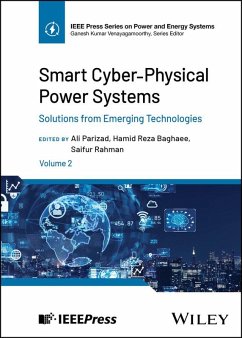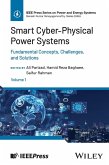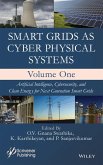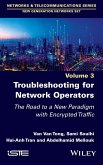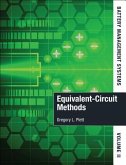ParizadSolutions from Emerging Technologies
Smart Cyber-Physical Power Systems, Volume 2
Solutions from Emerging Technologies
Herausgeber: Parizad, Ali; Rahman, Saifur; Baghaee, Hamid Reza
ParizadSolutions from Emerging Technologies
Smart Cyber-Physical Power Systems, Volume 2
Solutions from Emerging Technologies
Herausgeber: Parizad, Ali; Rahman, Saifur; Baghaee, Hamid Reza
- Gebundenes Buch
- Merkliste
- Auf die Merkliste
- Bewerten Bewerten
- Teilen
- Produkt teilen
- Produkterinnerung
- Produkterinnerung
A practical roadmap to the application of artificial intelligence and machine learning to power systems In an era where digital technologies are revolutionizing every aspect of power systems, Smart Cyber-Physical Power Systems, Volume 2: Solutions from Emerging Technologies shifts focus to cutting-edge solutions for overcoming the challenges faced by cyber-physical power systems (CPSs). By leveraging emerging technologies, this volume explores how innovations like artificial intelligence, machine learning, blockchain, quantum computing, digital twins, and data analytics are reshaping the…mehr
Andere Kunden interessierten sich auch für
![Smart Cyber-Physical Power Systems, Volume 1 Smart Cyber-Physical Power Systems, Volume 1]() ParizadSmart Cyber-Physical Power Systems, Volume 1119,99 €
ParizadSmart Cyber-Physical Power Systems, Volume 1119,99 €![Smart Cyber-Physical Power Systems: Challenges and Solutions, 2 Volume Set Smart Cyber-Physical Power Systems: Challenges and Solutions, 2 Volume Set]() A ParizadSmart Cyber-Physical Power Systems: Challenges and Solutions, 2 Volume Set177,99 €
A ParizadSmart Cyber-Physical Power Systems: Challenges and Solutions, 2 Volume Set177,99 €![Smart Grids as Cyber Physical Systems, 2 Volume Set Smart Grids as Cyber Physical Systems, 2 Volume Set]() OVG SwathikaSmart Grids as Cyber Physical Systems, 2 Volume Set242,99 €
OVG SwathikaSmart Grids as Cyber Physical Systems, 2 Volume Set242,99 €![Troubleshooting for Network Operators Troubleshooting for Network Operators]() Van Van TongTroubleshooting for Network Operators145,99 €
Van Van TongTroubleshooting for Network Operators145,99 €![Security and Privacy for 6g Massive Iot Security and Privacy for 6g Massive Iot]() MantasSecurity and Privacy for 6g Massive Iot124,99 €
MantasSecurity and Privacy for 6g Massive Iot124,99 €![6g-Enabled Technologies for Next Generation 6g-Enabled Technologies for Next Generation]() Amit Kumar Tyagi6g-Enabled Technologies for Next Generation133,99 €
Amit Kumar Tyagi6g-Enabled Technologies for Next Generation133,99 €![Battery Management Systems, Volume II Battery Management Systems, Volume II]() Gregory L. PlettBattery Management Systems, Volume II138,99 €
Gregory L. PlettBattery Management Systems, Volume II138,99 €-
-
-
A practical roadmap to the application of artificial intelligence and machine learning to power systems In an era where digital technologies are revolutionizing every aspect of power systems, Smart Cyber-Physical Power Systems, Volume 2: Solutions from Emerging Technologies shifts focus to cutting-edge solutions for overcoming the challenges faced by cyber-physical power systems (CPSs). By leveraging emerging technologies, this volume explores how innovations like artificial intelligence, machine learning, blockchain, quantum computing, digital twins, and data analytics are reshaping the energy sector. This volume delves into the application of AI and machine learning in power system optimization, protection, and forecasting. It also highlights the transformative role of blockchain in secure energy trading and digital twins in simulating real-time power system operations. Advanced big data techniques are presented for enhancing system planning, situational awareness, and stability, while quantum computing offers groundbreaking approaches to solving complex energy problems. For professionals and researchers eager to harness cutting-edge technologies within smart power systems, Volume 2 proves indispensable. Filled with numerous illustrations, case studies, and technical insights, it offers forward-thinking solutions that foster a more efficient, secure, and resilient future for global energy systems, heralding a new era of innovation and transformation in cyber-physical power networks. Welcome to the exploration of Smart Cyber-Physical Power Systems (CPPSs), where challenges are met with innovative solutions, and the future of energy is shaped by the paradigms of AI/ML, Big Data, Blockchain, IoT, Quantum Computing, Information Theory, Edge Computing, Metaverse, DevOps, and more.
Produktdetails
- Produktdetails
- Verlag: Wiley
- Seitenzahl: 624
- Erscheinungstermin: 12. März 2025
- Englisch
- Abmessung: 254mm x 178mm x 33mm
- Gewicht: 1293g
- ISBN-13: 9781394334568
- ISBN-10: 1394334567
- Artikelnr.: 72014997
- Herstellerkennzeichnung
- Libri GmbH
- Europaallee 1
- 36244 Bad Hersfeld
- gpsr@libri.de
- Verlag: Wiley
- Seitenzahl: 624
- Erscheinungstermin: 12. März 2025
- Englisch
- Abmessung: 254mm x 178mm x 33mm
- Gewicht: 1293g
- ISBN-13: 9781394334568
- ISBN-10: 1394334567
- Artikelnr.: 72014997
- Herstellerkennzeichnung
- Libri GmbH
- Europaallee 1
- 36244 Bad Hersfeld
- gpsr@libri.de
Ali Parizad, PhD, is a Postdoctoral Associate at the Advanced Research Institute (ARI) of Virginia Polytechnic Institute and State University, VA, USA. Leveraging his extensive academic background, he served as a Senior Data Scientist in the IDA Data Science & Machine Learning (DSML) Department at Shell Energy. He holds the position of Staff Power Systems Machine Learning Engineer at Thinklabs AI, where he tackles critical challenges in power systems with cutting-edge AI applications. Hamid Reza Baghaee, PhD, is an Associate Research Professor at Amirkabir University of Technology, Tehran, Iran. Saifur Rahman, PhD, is the founding director of the Advanced Research Institute at Virginia Tech, where he is the Joseph R. Loring Professor of Electrical and Computer Engineering.
About the Editors xxi
List of Contributors xxv
Foreword (John D. McDonald) xxxi
Foreword (Massoud Amin) xxxiii
Preface for Volume 2: Smart Cyber-Physical Power Systems: Solutions from
Emerging Technologies xxxvii
Acknowledgments xxxix
1 Information Theory and Gray Level Transformation Techniques in Detecting
False Data Injection Attacks on Power System State Estimation 1
Ali Parizad and Constantine Hatziadoniu
1.1 Introduction 1
1.2 Cyber-attacks on the State Variables of the Power System 2
1.3 Information Theory 4
1.4 Gray Level Transformation 6
1.5 Linear Transformation 7
1.6 Logarithmic Transformations 7
1.7 Power-Law Transformations 7
1.8 Simulation Results 8
1.9 Conclusion 44
References 45
2 Artificial Intelligence and Machine Learning Applications in Modern Power
Systems 49
Sohom Datta, Zhangshuan Hou, Milan Jain, and Syed Ahsan Raza Naqvi
2.1 The Need for AI/ML in Modern Power Systems 49
2.2 AL/ML Algorithms in Power System Applications 49
2.3 AI/ML-Based Applications in the Electricity Grid 52
2.4 Future of AI/ML in Power Systems 61
References 62
3 Physics-Informed Deep Reinforcement Learning-Based Control in Power
Systems 67
Ramij Raja Hossain, Qiuhua Huang, Kaveri Mahapatra, and Renke Huang
3.1 Introduction 67
3.2 Overview of RL/DRL 69
3.3 Grid Control Perspectives 70
3.4 Importance of Physics-Informed DRL in Grid Control and Different
Methods 71
3.5 Grid Control Applications of Physics-Informed DRL 72
3.6 Discussion and Research Directions 74
3.7 Conclusions 75
References 75
4 Digital Twin Approach Toward Modern Power Systems 79
Sabrieh Choobkar
4.1 Digital Twin Concept 79
4.2 Digital Twin: The Convergence of Recent Technologies 84
4.3 Cyber-Physical System and Digital Twin 87
4.4 Novelties and Suggestions of Digital Twin to Smart Grid Subsystems 88
4.5 Conclusions 90
References 90
5 Application of AI and Machine Learning Algorithms in Power System State
Estimation 93
Behrouz Azimian, Reetam Sen Biswas, and Anamitra Pal
5.1 Introduction 93
5.2 Motivation and Theoretical Background 95
5.3 DNN Architecture for DSSE and TI 97
5.4 SMD Measurement Selection for DSSE and TI 98
5.5 Smart Meter Data Consideration 104
5.6 Implementation of DNN-Based TI and DSSE 114
5.7 Conclusion 126
Acknowledgment 127
Appendix 127
References 128
6 ANN-Based Scenario Generation Approach for Energy Management of Smart
Buildings 131
Mahoor Ebrahimi, Mahan Ebrahimi, Miadreza Shafie-khah, Hannu Laaksonen, and
Pierluigi Siano
6.1 Introduction 131
6.2 Problem Formulation 132
6.3 Application of AI in Energy Management of Smart Homes 137
6.4 Simulation and Results 139
6.5 Conclusion 145
References 146
7 Protection Challenges and Solutions in Power Grids by AI/Machine Learning
149
Ali Bidram
7.1 Introduction 149
7.2 Zonal Setting-Less Modular Protection Using ml 150
7.3 Traveling Wave Protection of dc Microgrids Using ml 159
7.4 Conclusion 168
References 168
8 Deep and Reinforcement Learning for Active Distribution Network
Protection 171
Mohammed AlSaba and Mohammad Abido
8.1 Introduction and Motivation 171
8.2 Problem Statement 173
8.3 Proposed Methodology for Fault Detection and Classification 177
8.4 Case Study and Implementation 178
8.5 Results and Discussion 180
8.6 Hardware in-the-Loop Testing 186
8.7 Conclusion 186
Acknowledgments 187
References 187
9 Handling and Application of Big Data in Modern Power Systems for
Planning, Operation, and Control Processes 189
Meghana Ramesh, Jing Xie, Monish Mukherjee, Thomas E. McDermott, Anjan
Bose, and Michael Diedesch
9.1 Introduction 189
9.2 Intelligent Modeling and Its Applications 190
9.3 Case Study 193
9.4 Conclusions 206
Acknowledgment 206
References 207
10 Handling and Application of Big Data in Modern Power Systems for
Situational Awareness and Operation 209
Yingqi Liang, Junbo Zhao, and Dipti Srinivasan
10.1 Introduction 209
10.2 Challenges for Using Big Data Techniques in Smart Grids 209
10.3 Solutions Using Big Data Techniques for Smart Grid Situational
Awareness 211
10.4 Applications of Big Data Techniques for Smart Grid Operation 228
10.5 Numerical Results 231
10.6 Concluding 250
References 251
11 Data-Driven Methods in Modern Power System Stability and Security 255
Jinpeng Guo, Georgia Pierrou, Xiaoting Wang, Mohan Du, and Xiaozhe Wang
11.1 Introduction 255
11.2 Data-Driven Wide-Area Damping Control 256
11.3 Data-Driven Wide-Area Voltage Control 266
11.4 Data-Driven Inertia Estimation for Frequency Control 274
11.5 A Data-Driven Polynomial Chaos Expansion Method for Available Transfer
Capability Assessment 284
11.6 Using PCE to Assess the Ramping Support Capability of a Microgrid 297
References 305
12 Application of Quantum Computing for Power Systems 313
Yan Li, Ganesh K. Venayagamoorthy, and Liang Du
12.1 Quantum Computing in Renewable Energy Systems 313
12.2 Quantum Approximate Optimization Algorithm for Renewable Energy
Systems 316
12.3 Typical Applications of Quantum Computing 319
Acknowledgment 320
References 320
13 High-Resolution Building-Level Load Forecasting Employing Convolutional
Neural Networks (CNNs) and Cloud Computing Techniques: Part 1 Principles
and Concepts 323
Zejia Jing, Ali Parizad, and Saifur Rahman
13.1 Introduction 323
13.2 Principles and Concepts of Building Hourly Energy Consumption
Forecasting 325
13.3 Conclusion 359
References 359
14 High-Resolution Building-Level Load Forecasting Employing Convolutional
Neural Networks (CNNs) and Cloud Computing Techniques: Part 2 Simulation
and Experimental Results 363
Zejia Jing, Ali Parizad, and Saifur Rahman
14.1 Introduction 363
14.2 Case Study and Result of Building Hourly Energy Consumption
Forecasting 364
14.3 Building Occupancy Measurement 394
14.4 Conclusion 409
15 PV Energy Forecasting Applying Machine Learning Methods Targeting Energy
Trading Systems 417
Zejia Jing, Ali Parizad, and Saifur Rahman
15.1 Introduction 417
15.2 PV Energy Forecasting 418
15.3 Conclusion 447
References 447
16 An Intelligent Reinforcement-Learning-Based Load Shedding to Prevent
Voltage Instability 449
Pouria Akbarzadeh Aghdam, Hamid Khoshkhoo, and Ahmad Akbari
16.1 Introduction 449
16.2 Stability Control Methods 450
16.3 Characteristics of Optimal Stability Controller 451
16.4 Utilizing Reinforcement Learning for Enhancing Voltage Stability 452
16.5 Taxonomy of RL 455
16.6 Proposed Algorithm 456
16.7 Reinforcement Learning Algorithm Components 456
16.8 Algorithm Implementation Process 458
16.9 Simulations and Results 460
16.10 Scenario I 462
16.11 Scenario II 463
16.12 Scenario III 465
16.13 Conclusion 466
References 466
17 Deep Learning Techniques for Solving Optimal Power Flow Problems 471
Vassilis Kekatos and Manish K. Singh
17.1 Introduction 471
17.2 Sensitivity-Informed Learning for OPF 473
17.3 Deep Learning for Stochastic OPF 487
17.4 Conclusions 497
References 497
18 Research on Intelligent Prediction of Spatial-Temporal Dynamic Frequency
Response and Performance Evaluation 501
Xieli Sun, Longyu Chen, and Xiaoru Wang
18.1 Introduction 501
18.2 Modeling Process and Evaluation Method 503
18.3 Case Study 515
18.4 Conclusion 522
References 522
19 Emerging Technologies and Future Trends in Cyber-Physical Power Systems:
Toward a New Era of Innovations 525
Ali Parizad, Hamid Reza Baghaee, Vahid Alizadeh, and Saifur Rahman
19.1 Introduction 525
19.2 Paradigm Shifts in Power Transmission and Management 526
19.3 Innovations in Electric Mobility and Sustainable Transportation 530
19.4 Digital Transformation and Technological Convergence in Cyber-Physical
Power Systems 530
19.5 Cyber-Physical Systems Enhancing Societal Well-Being 539
19.6 Toward a Decentralized and Automated Future 540
19.7 Overcoming Challenges with Advanced Technologies 541
19.8 Revolutionizing Modern Power Systems with Real-Time Simulators 547
19.9 Emerging Trends Shaping the Future Energy Landscape 549
19.10 Conclusion 552
References 553
Index 567
List of Contributors xxv
Foreword (John D. McDonald) xxxi
Foreword (Massoud Amin) xxxiii
Preface for Volume 2: Smart Cyber-Physical Power Systems: Solutions from
Emerging Technologies xxxvii
Acknowledgments xxxix
1 Information Theory and Gray Level Transformation Techniques in Detecting
False Data Injection Attacks on Power System State Estimation 1
Ali Parizad and Constantine Hatziadoniu
1.1 Introduction 1
1.2 Cyber-attacks on the State Variables of the Power System 2
1.3 Information Theory 4
1.4 Gray Level Transformation 6
1.5 Linear Transformation 7
1.6 Logarithmic Transformations 7
1.7 Power-Law Transformations 7
1.8 Simulation Results 8
1.9 Conclusion 44
References 45
2 Artificial Intelligence and Machine Learning Applications in Modern Power
Systems 49
Sohom Datta, Zhangshuan Hou, Milan Jain, and Syed Ahsan Raza Naqvi
2.1 The Need for AI/ML in Modern Power Systems 49
2.2 AL/ML Algorithms in Power System Applications 49
2.3 AI/ML-Based Applications in the Electricity Grid 52
2.4 Future of AI/ML in Power Systems 61
References 62
3 Physics-Informed Deep Reinforcement Learning-Based Control in Power
Systems 67
Ramij Raja Hossain, Qiuhua Huang, Kaveri Mahapatra, and Renke Huang
3.1 Introduction 67
3.2 Overview of RL/DRL 69
3.3 Grid Control Perspectives 70
3.4 Importance of Physics-Informed DRL in Grid Control and Different
Methods 71
3.5 Grid Control Applications of Physics-Informed DRL 72
3.6 Discussion and Research Directions 74
3.7 Conclusions 75
References 75
4 Digital Twin Approach Toward Modern Power Systems 79
Sabrieh Choobkar
4.1 Digital Twin Concept 79
4.2 Digital Twin: The Convergence of Recent Technologies 84
4.3 Cyber-Physical System and Digital Twin 87
4.4 Novelties and Suggestions of Digital Twin to Smart Grid Subsystems 88
4.5 Conclusions 90
References 90
5 Application of AI and Machine Learning Algorithms in Power System State
Estimation 93
Behrouz Azimian, Reetam Sen Biswas, and Anamitra Pal
5.1 Introduction 93
5.2 Motivation and Theoretical Background 95
5.3 DNN Architecture for DSSE and TI 97
5.4 SMD Measurement Selection for DSSE and TI 98
5.5 Smart Meter Data Consideration 104
5.6 Implementation of DNN-Based TI and DSSE 114
5.7 Conclusion 126
Acknowledgment 127
Appendix 127
References 128
6 ANN-Based Scenario Generation Approach for Energy Management of Smart
Buildings 131
Mahoor Ebrahimi, Mahan Ebrahimi, Miadreza Shafie-khah, Hannu Laaksonen, and
Pierluigi Siano
6.1 Introduction 131
6.2 Problem Formulation 132
6.3 Application of AI in Energy Management of Smart Homes 137
6.4 Simulation and Results 139
6.5 Conclusion 145
References 146
7 Protection Challenges and Solutions in Power Grids by AI/Machine Learning
149
Ali Bidram
7.1 Introduction 149
7.2 Zonal Setting-Less Modular Protection Using ml 150
7.3 Traveling Wave Protection of dc Microgrids Using ml 159
7.4 Conclusion 168
References 168
8 Deep and Reinforcement Learning for Active Distribution Network
Protection 171
Mohammed AlSaba and Mohammad Abido
8.1 Introduction and Motivation 171
8.2 Problem Statement 173
8.3 Proposed Methodology for Fault Detection and Classification 177
8.4 Case Study and Implementation 178
8.5 Results and Discussion 180
8.6 Hardware in-the-Loop Testing 186
8.7 Conclusion 186
Acknowledgments 187
References 187
9 Handling and Application of Big Data in Modern Power Systems for
Planning, Operation, and Control Processes 189
Meghana Ramesh, Jing Xie, Monish Mukherjee, Thomas E. McDermott, Anjan
Bose, and Michael Diedesch
9.1 Introduction 189
9.2 Intelligent Modeling and Its Applications 190
9.3 Case Study 193
9.4 Conclusions 206
Acknowledgment 206
References 207
10 Handling and Application of Big Data in Modern Power Systems for
Situational Awareness and Operation 209
Yingqi Liang, Junbo Zhao, and Dipti Srinivasan
10.1 Introduction 209
10.2 Challenges for Using Big Data Techniques in Smart Grids 209
10.3 Solutions Using Big Data Techniques for Smart Grid Situational
Awareness 211
10.4 Applications of Big Data Techniques for Smart Grid Operation 228
10.5 Numerical Results 231
10.6 Concluding 250
References 251
11 Data-Driven Methods in Modern Power System Stability and Security 255
Jinpeng Guo, Georgia Pierrou, Xiaoting Wang, Mohan Du, and Xiaozhe Wang
11.1 Introduction 255
11.2 Data-Driven Wide-Area Damping Control 256
11.3 Data-Driven Wide-Area Voltage Control 266
11.4 Data-Driven Inertia Estimation for Frequency Control 274
11.5 A Data-Driven Polynomial Chaos Expansion Method for Available Transfer
Capability Assessment 284
11.6 Using PCE to Assess the Ramping Support Capability of a Microgrid 297
References 305
12 Application of Quantum Computing for Power Systems 313
Yan Li, Ganesh K. Venayagamoorthy, and Liang Du
12.1 Quantum Computing in Renewable Energy Systems 313
12.2 Quantum Approximate Optimization Algorithm for Renewable Energy
Systems 316
12.3 Typical Applications of Quantum Computing 319
Acknowledgment 320
References 320
13 High-Resolution Building-Level Load Forecasting Employing Convolutional
Neural Networks (CNNs) and Cloud Computing Techniques: Part 1 Principles
and Concepts 323
Zejia Jing, Ali Parizad, and Saifur Rahman
13.1 Introduction 323
13.2 Principles and Concepts of Building Hourly Energy Consumption
Forecasting 325
13.3 Conclusion 359
References 359
14 High-Resolution Building-Level Load Forecasting Employing Convolutional
Neural Networks (CNNs) and Cloud Computing Techniques: Part 2 Simulation
and Experimental Results 363
Zejia Jing, Ali Parizad, and Saifur Rahman
14.1 Introduction 363
14.2 Case Study and Result of Building Hourly Energy Consumption
Forecasting 364
14.3 Building Occupancy Measurement 394
14.4 Conclusion 409
15 PV Energy Forecasting Applying Machine Learning Methods Targeting Energy
Trading Systems 417
Zejia Jing, Ali Parizad, and Saifur Rahman
15.1 Introduction 417
15.2 PV Energy Forecasting 418
15.3 Conclusion 447
References 447
16 An Intelligent Reinforcement-Learning-Based Load Shedding to Prevent
Voltage Instability 449
Pouria Akbarzadeh Aghdam, Hamid Khoshkhoo, and Ahmad Akbari
16.1 Introduction 449
16.2 Stability Control Methods 450
16.3 Characteristics of Optimal Stability Controller 451
16.4 Utilizing Reinforcement Learning for Enhancing Voltage Stability 452
16.5 Taxonomy of RL 455
16.6 Proposed Algorithm 456
16.7 Reinforcement Learning Algorithm Components 456
16.8 Algorithm Implementation Process 458
16.9 Simulations and Results 460
16.10 Scenario I 462
16.11 Scenario II 463
16.12 Scenario III 465
16.13 Conclusion 466
References 466
17 Deep Learning Techniques for Solving Optimal Power Flow Problems 471
Vassilis Kekatos and Manish K. Singh
17.1 Introduction 471
17.2 Sensitivity-Informed Learning for OPF 473
17.3 Deep Learning for Stochastic OPF 487
17.4 Conclusions 497
References 497
18 Research on Intelligent Prediction of Spatial-Temporal Dynamic Frequency
Response and Performance Evaluation 501
Xieli Sun, Longyu Chen, and Xiaoru Wang
18.1 Introduction 501
18.2 Modeling Process and Evaluation Method 503
18.3 Case Study 515
18.4 Conclusion 522
References 522
19 Emerging Technologies and Future Trends in Cyber-Physical Power Systems:
Toward a New Era of Innovations 525
Ali Parizad, Hamid Reza Baghaee, Vahid Alizadeh, and Saifur Rahman
19.1 Introduction 525
19.2 Paradigm Shifts in Power Transmission and Management 526
19.3 Innovations in Electric Mobility and Sustainable Transportation 530
19.4 Digital Transformation and Technological Convergence in Cyber-Physical
Power Systems 530
19.5 Cyber-Physical Systems Enhancing Societal Well-Being 539
19.6 Toward a Decentralized and Automated Future 540
19.7 Overcoming Challenges with Advanced Technologies 541
19.8 Revolutionizing Modern Power Systems with Real-Time Simulators 547
19.9 Emerging Trends Shaping the Future Energy Landscape 549
19.10 Conclusion 552
References 553
Index 567
About the Editors xxi
List of Contributors xxv
Foreword (John D. McDonald) xxxi
Foreword (Massoud Amin) xxxiii
Preface for Volume 2: Smart Cyber-Physical Power Systems: Solutions from
Emerging Technologies xxxvii
Acknowledgments xxxix
1 Information Theory and Gray Level Transformation Techniques in Detecting
False Data Injection Attacks on Power System State Estimation 1
Ali Parizad and Constantine Hatziadoniu
1.1 Introduction 1
1.2 Cyber-attacks on the State Variables of the Power System 2
1.3 Information Theory 4
1.4 Gray Level Transformation 6
1.5 Linear Transformation 7
1.6 Logarithmic Transformations 7
1.7 Power-Law Transformations 7
1.8 Simulation Results 8
1.9 Conclusion 44
References 45
2 Artificial Intelligence and Machine Learning Applications in Modern Power
Systems 49
Sohom Datta, Zhangshuan Hou, Milan Jain, and Syed Ahsan Raza Naqvi
2.1 The Need for AI/ML in Modern Power Systems 49
2.2 AL/ML Algorithms in Power System Applications 49
2.3 AI/ML-Based Applications in the Electricity Grid 52
2.4 Future of AI/ML in Power Systems 61
References 62
3 Physics-Informed Deep Reinforcement Learning-Based Control in Power
Systems 67
Ramij Raja Hossain, Qiuhua Huang, Kaveri Mahapatra, and Renke Huang
3.1 Introduction 67
3.2 Overview of RL/DRL 69
3.3 Grid Control Perspectives 70
3.4 Importance of Physics-Informed DRL in Grid Control and Different
Methods 71
3.5 Grid Control Applications of Physics-Informed DRL 72
3.6 Discussion and Research Directions 74
3.7 Conclusions 75
References 75
4 Digital Twin Approach Toward Modern Power Systems 79
Sabrieh Choobkar
4.1 Digital Twin Concept 79
4.2 Digital Twin: The Convergence of Recent Technologies 84
4.3 Cyber-Physical System and Digital Twin 87
4.4 Novelties and Suggestions of Digital Twin to Smart Grid Subsystems 88
4.5 Conclusions 90
References 90
5 Application of AI and Machine Learning Algorithms in Power System State
Estimation 93
Behrouz Azimian, Reetam Sen Biswas, and Anamitra Pal
5.1 Introduction 93
5.2 Motivation and Theoretical Background 95
5.3 DNN Architecture for DSSE and TI 97
5.4 SMD Measurement Selection for DSSE and TI 98
5.5 Smart Meter Data Consideration 104
5.6 Implementation of DNN-Based TI and DSSE 114
5.7 Conclusion 126
Acknowledgment 127
Appendix 127
References 128
6 ANN-Based Scenario Generation Approach for Energy Management of Smart
Buildings 131
Mahoor Ebrahimi, Mahan Ebrahimi, Miadreza Shafie-khah, Hannu Laaksonen, and
Pierluigi Siano
6.1 Introduction 131
6.2 Problem Formulation 132
6.3 Application of AI in Energy Management of Smart Homes 137
6.4 Simulation and Results 139
6.5 Conclusion 145
References 146
7 Protection Challenges and Solutions in Power Grids by AI/Machine Learning
149
Ali Bidram
7.1 Introduction 149
7.2 Zonal Setting-Less Modular Protection Using ml 150
7.3 Traveling Wave Protection of dc Microgrids Using ml 159
7.4 Conclusion 168
References 168
8 Deep and Reinforcement Learning for Active Distribution Network
Protection 171
Mohammed AlSaba and Mohammad Abido
8.1 Introduction and Motivation 171
8.2 Problem Statement 173
8.3 Proposed Methodology for Fault Detection and Classification 177
8.4 Case Study and Implementation 178
8.5 Results and Discussion 180
8.6 Hardware in-the-Loop Testing 186
8.7 Conclusion 186
Acknowledgments 187
References 187
9 Handling and Application of Big Data in Modern Power Systems for
Planning, Operation, and Control Processes 189
Meghana Ramesh, Jing Xie, Monish Mukherjee, Thomas E. McDermott, Anjan
Bose, and Michael Diedesch
9.1 Introduction 189
9.2 Intelligent Modeling and Its Applications 190
9.3 Case Study 193
9.4 Conclusions 206
Acknowledgment 206
References 207
10 Handling and Application of Big Data in Modern Power Systems for
Situational Awareness and Operation 209
Yingqi Liang, Junbo Zhao, and Dipti Srinivasan
10.1 Introduction 209
10.2 Challenges for Using Big Data Techniques in Smart Grids 209
10.3 Solutions Using Big Data Techniques for Smart Grid Situational
Awareness 211
10.4 Applications of Big Data Techniques for Smart Grid Operation 228
10.5 Numerical Results 231
10.6 Concluding 250
References 251
11 Data-Driven Methods in Modern Power System Stability and Security 255
Jinpeng Guo, Georgia Pierrou, Xiaoting Wang, Mohan Du, and Xiaozhe Wang
11.1 Introduction 255
11.2 Data-Driven Wide-Area Damping Control 256
11.3 Data-Driven Wide-Area Voltage Control 266
11.4 Data-Driven Inertia Estimation for Frequency Control 274
11.5 A Data-Driven Polynomial Chaos Expansion Method for Available Transfer
Capability Assessment 284
11.6 Using PCE to Assess the Ramping Support Capability of a Microgrid 297
References 305
12 Application of Quantum Computing for Power Systems 313
Yan Li, Ganesh K. Venayagamoorthy, and Liang Du
12.1 Quantum Computing in Renewable Energy Systems 313
12.2 Quantum Approximate Optimization Algorithm for Renewable Energy
Systems 316
12.3 Typical Applications of Quantum Computing 319
Acknowledgment 320
References 320
13 High-Resolution Building-Level Load Forecasting Employing Convolutional
Neural Networks (CNNs) and Cloud Computing Techniques: Part 1 Principles
and Concepts 323
Zejia Jing, Ali Parizad, and Saifur Rahman
13.1 Introduction 323
13.2 Principles and Concepts of Building Hourly Energy Consumption
Forecasting 325
13.3 Conclusion 359
References 359
14 High-Resolution Building-Level Load Forecasting Employing Convolutional
Neural Networks (CNNs) and Cloud Computing Techniques: Part 2 Simulation
and Experimental Results 363
Zejia Jing, Ali Parizad, and Saifur Rahman
14.1 Introduction 363
14.2 Case Study and Result of Building Hourly Energy Consumption
Forecasting 364
14.3 Building Occupancy Measurement 394
14.4 Conclusion 409
15 PV Energy Forecasting Applying Machine Learning Methods Targeting Energy
Trading Systems 417
Zejia Jing, Ali Parizad, and Saifur Rahman
15.1 Introduction 417
15.2 PV Energy Forecasting 418
15.3 Conclusion 447
References 447
16 An Intelligent Reinforcement-Learning-Based Load Shedding to Prevent
Voltage Instability 449
Pouria Akbarzadeh Aghdam, Hamid Khoshkhoo, and Ahmad Akbari
16.1 Introduction 449
16.2 Stability Control Methods 450
16.3 Characteristics of Optimal Stability Controller 451
16.4 Utilizing Reinforcement Learning for Enhancing Voltage Stability 452
16.5 Taxonomy of RL 455
16.6 Proposed Algorithm 456
16.7 Reinforcement Learning Algorithm Components 456
16.8 Algorithm Implementation Process 458
16.9 Simulations and Results 460
16.10 Scenario I 462
16.11 Scenario II 463
16.12 Scenario III 465
16.13 Conclusion 466
References 466
17 Deep Learning Techniques for Solving Optimal Power Flow Problems 471
Vassilis Kekatos and Manish K. Singh
17.1 Introduction 471
17.2 Sensitivity-Informed Learning for OPF 473
17.3 Deep Learning for Stochastic OPF 487
17.4 Conclusions 497
References 497
18 Research on Intelligent Prediction of Spatial-Temporal Dynamic Frequency
Response and Performance Evaluation 501
Xieli Sun, Longyu Chen, and Xiaoru Wang
18.1 Introduction 501
18.2 Modeling Process and Evaluation Method 503
18.3 Case Study 515
18.4 Conclusion 522
References 522
19 Emerging Technologies and Future Trends in Cyber-Physical Power Systems:
Toward a New Era of Innovations 525
Ali Parizad, Hamid Reza Baghaee, Vahid Alizadeh, and Saifur Rahman
19.1 Introduction 525
19.2 Paradigm Shifts in Power Transmission and Management 526
19.3 Innovations in Electric Mobility and Sustainable Transportation 530
19.4 Digital Transformation and Technological Convergence in Cyber-Physical
Power Systems 530
19.5 Cyber-Physical Systems Enhancing Societal Well-Being 539
19.6 Toward a Decentralized and Automated Future 540
19.7 Overcoming Challenges with Advanced Technologies 541
19.8 Revolutionizing Modern Power Systems with Real-Time Simulators 547
19.9 Emerging Trends Shaping the Future Energy Landscape 549
19.10 Conclusion 552
References 553
Index 567
List of Contributors xxv
Foreword (John D. McDonald) xxxi
Foreword (Massoud Amin) xxxiii
Preface for Volume 2: Smart Cyber-Physical Power Systems: Solutions from
Emerging Technologies xxxvii
Acknowledgments xxxix
1 Information Theory and Gray Level Transformation Techniques in Detecting
False Data Injection Attacks on Power System State Estimation 1
Ali Parizad and Constantine Hatziadoniu
1.1 Introduction 1
1.2 Cyber-attacks on the State Variables of the Power System 2
1.3 Information Theory 4
1.4 Gray Level Transformation 6
1.5 Linear Transformation 7
1.6 Logarithmic Transformations 7
1.7 Power-Law Transformations 7
1.8 Simulation Results 8
1.9 Conclusion 44
References 45
2 Artificial Intelligence and Machine Learning Applications in Modern Power
Systems 49
Sohom Datta, Zhangshuan Hou, Milan Jain, and Syed Ahsan Raza Naqvi
2.1 The Need for AI/ML in Modern Power Systems 49
2.2 AL/ML Algorithms in Power System Applications 49
2.3 AI/ML-Based Applications in the Electricity Grid 52
2.4 Future of AI/ML in Power Systems 61
References 62
3 Physics-Informed Deep Reinforcement Learning-Based Control in Power
Systems 67
Ramij Raja Hossain, Qiuhua Huang, Kaveri Mahapatra, and Renke Huang
3.1 Introduction 67
3.2 Overview of RL/DRL 69
3.3 Grid Control Perspectives 70
3.4 Importance of Physics-Informed DRL in Grid Control and Different
Methods 71
3.5 Grid Control Applications of Physics-Informed DRL 72
3.6 Discussion and Research Directions 74
3.7 Conclusions 75
References 75
4 Digital Twin Approach Toward Modern Power Systems 79
Sabrieh Choobkar
4.1 Digital Twin Concept 79
4.2 Digital Twin: The Convergence of Recent Technologies 84
4.3 Cyber-Physical System and Digital Twin 87
4.4 Novelties and Suggestions of Digital Twin to Smart Grid Subsystems 88
4.5 Conclusions 90
References 90
5 Application of AI and Machine Learning Algorithms in Power System State
Estimation 93
Behrouz Azimian, Reetam Sen Biswas, and Anamitra Pal
5.1 Introduction 93
5.2 Motivation and Theoretical Background 95
5.3 DNN Architecture for DSSE and TI 97
5.4 SMD Measurement Selection for DSSE and TI 98
5.5 Smart Meter Data Consideration 104
5.6 Implementation of DNN-Based TI and DSSE 114
5.7 Conclusion 126
Acknowledgment 127
Appendix 127
References 128
6 ANN-Based Scenario Generation Approach for Energy Management of Smart
Buildings 131
Mahoor Ebrahimi, Mahan Ebrahimi, Miadreza Shafie-khah, Hannu Laaksonen, and
Pierluigi Siano
6.1 Introduction 131
6.2 Problem Formulation 132
6.3 Application of AI in Energy Management of Smart Homes 137
6.4 Simulation and Results 139
6.5 Conclusion 145
References 146
7 Protection Challenges and Solutions in Power Grids by AI/Machine Learning
149
Ali Bidram
7.1 Introduction 149
7.2 Zonal Setting-Less Modular Protection Using ml 150
7.3 Traveling Wave Protection of dc Microgrids Using ml 159
7.4 Conclusion 168
References 168
8 Deep and Reinforcement Learning for Active Distribution Network
Protection 171
Mohammed AlSaba and Mohammad Abido
8.1 Introduction and Motivation 171
8.2 Problem Statement 173
8.3 Proposed Methodology for Fault Detection and Classification 177
8.4 Case Study and Implementation 178
8.5 Results and Discussion 180
8.6 Hardware in-the-Loop Testing 186
8.7 Conclusion 186
Acknowledgments 187
References 187
9 Handling and Application of Big Data in Modern Power Systems for
Planning, Operation, and Control Processes 189
Meghana Ramesh, Jing Xie, Monish Mukherjee, Thomas E. McDermott, Anjan
Bose, and Michael Diedesch
9.1 Introduction 189
9.2 Intelligent Modeling and Its Applications 190
9.3 Case Study 193
9.4 Conclusions 206
Acknowledgment 206
References 207
10 Handling and Application of Big Data in Modern Power Systems for
Situational Awareness and Operation 209
Yingqi Liang, Junbo Zhao, and Dipti Srinivasan
10.1 Introduction 209
10.2 Challenges for Using Big Data Techniques in Smart Grids 209
10.3 Solutions Using Big Data Techniques for Smart Grid Situational
Awareness 211
10.4 Applications of Big Data Techniques for Smart Grid Operation 228
10.5 Numerical Results 231
10.6 Concluding 250
References 251
11 Data-Driven Methods in Modern Power System Stability and Security 255
Jinpeng Guo, Georgia Pierrou, Xiaoting Wang, Mohan Du, and Xiaozhe Wang
11.1 Introduction 255
11.2 Data-Driven Wide-Area Damping Control 256
11.3 Data-Driven Wide-Area Voltage Control 266
11.4 Data-Driven Inertia Estimation for Frequency Control 274
11.5 A Data-Driven Polynomial Chaos Expansion Method for Available Transfer
Capability Assessment 284
11.6 Using PCE to Assess the Ramping Support Capability of a Microgrid 297
References 305
12 Application of Quantum Computing for Power Systems 313
Yan Li, Ganesh K. Venayagamoorthy, and Liang Du
12.1 Quantum Computing in Renewable Energy Systems 313
12.2 Quantum Approximate Optimization Algorithm for Renewable Energy
Systems 316
12.3 Typical Applications of Quantum Computing 319
Acknowledgment 320
References 320
13 High-Resolution Building-Level Load Forecasting Employing Convolutional
Neural Networks (CNNs) and Cloud Computing Techniques: Part 1 Principles
and Concepts 323
Zejia Jing, Ali Parizad, and Saifur Rahman
13.1 Introduction 323
13.2 Principles and Concepts of Building Hourly Energy Consumption
Forecasting 325
13.3 Conclusion 359
References 359
14 High-Resolution Building-Level Load Forecasting Employing Convolutional
Neural Networks (CNNs) and Cloud Computing Techniques: Part 2 Simulation
and Experimental Results 363
Zejia Jing, Ali Parizad, and Saifur Rahman
14.1 Introduction 363
14.2 Case Study and Result of Building Hourly Energy Consumption
Forecasting 364
14.3 Building Occupancy Measurement 394
14.4 Conclusion 409
15 PV Energy Forecasting Applying Machine Learning Methods Targeting Energy
Trading Systems 417
Zejia Jing, Ali Parizad, and Saifur Rahman
15.1 Introduction 417
15.2 PV Energy Forecasting 418
15.3 Conclusion 447
References 447
16 An Intelligent Reinforcement-Learning-Based Load Shedding to Prevent
Voltage Instability 449
Pouria Akbarzadeh Aghdam, Hamid Khoshkhoo, and Ahmad Akbari
16.1 Introduction 449
16.2 Stability Control Methods 450
16.3 Characteristics of Optimal Stability Controller 451
16.4 Utilizing Reinforcement Learning for Enhancing Voltage Stability 452
16.5 Taxonomy of RL 455
16.6 Proposed Algorithm 456
16.7 Reinforcement Learning Algorithm Components 456
16.8 Algorithm Implementation Process 458
16.9 Simulations and Results 460
16.10 Scenario I 462
16.11 Scenario II 463
16.12 Scenario III 465
16.13 Conclusion 466
References 466
17 Deep Learning Techniques for Solving Optimal Power Flow Problems 471
Vassilis Kekatos and Manish K. Singh
17.1 Introduction 471
17.2 Sensitivity-Informed Learning for OPF 473
17.3 Deep Learning for Stochastic OPF 487
17.4 Conclusions 497
References 497
18 Research on Intelligent Prediction of Spatial-Temporal Dynamic Frequency
Response and Performance Evaluation 501
Xieli Sun, Longyu Chen, and Xiaoru Wang
18.1 Introduction 501
18.2 Modeling Process and Evaluation Method 503
18.3 Case Study 515
18.4 Conclusion 522
References 522
19 Emerging Technologies and Future Trends in Cyber-Physical Power Systems:
Toward a New Era of Innovations 525
Ali Parizad, Hamid Reza Baghaee, Vahid Alizadeh, and Saifur Rahman
19.1 Introduction 525
19.2 Paradigm Shifts in Power Transmission and Management 526
19.3 Innovations in Electric Mobility and Sustainable Transportation 530
19.4 Digital Transformation and Technological Convergence in Cyber-Physical
Power Systems 530
19.5 Cyber-Physical Systems Enhancing Societal Well-Being 539
19.6 Toward a Decentralized and Automated Future 540
19.7 Overcoming Challenges with Advanced Technologies 541
19.8 Revolutionizing Modern Power Systems with Real-Time Simulators 547
19.9 Emerging Trends Shaping the Future Energy Landscape 549
19.10 Conclusion 552
References 553
Index 567

